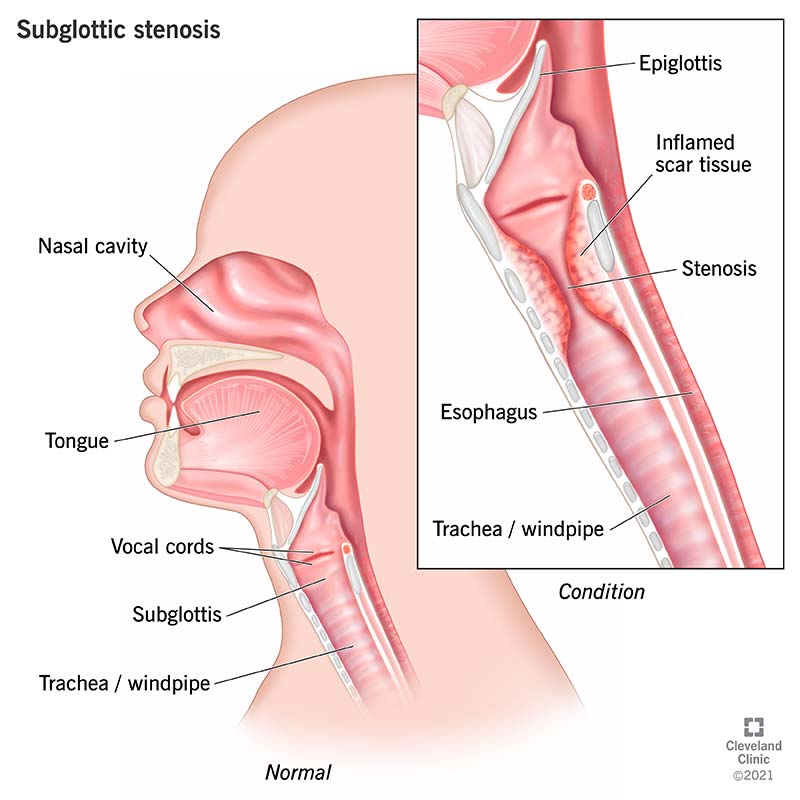Subglottic stenosis is a narrowing of your trachea (windpipe). It can be congenital (present at birth) or develop during your lifetime. It may develop for no known reason (idiopathic subglottic stenosis). Symptoms include a whistling noise when you breathe or shortness of breath. Treatment includes surgery to widen the narrow area in your windpipe.
Advertisement
Cleveland Clinic is a non-profit academic medical center. Advertising on our site helps support our mission. We do not endorse non-Cleveland Clinic products or services. Policy

Subglottic stenosis is when the upper section of your trachea (windpipe) is narrower than usual so that there’s a whistling noise when you breathe, or you feel short of breath. “Subglottic” means the part of your trachea just below your vocal cords and “stenosis” means there’s a narrowing.
Advertisement
Cleveland Clinic is a non-profit academic medical center. Advertising on our site helps support our mission. We do not endorse non-Cleveland Clinic products or services. Policy
Anyone can have subglottic stenosis. Your newborn baby may be born with an unusually narrow airway (congenital subglottic stenosis). Or you could develop it after you’re born (acquired subglottic stenosis). Several things may cause subglottic stenosis in adults, but it can happen for no known reason (idiopathic subglottic stenosis).
Without treatment, severe subglottic stenosis can be life-threatening. But treatment to widen the narrow area in your windpipe can effectively treat the condition.
Subglottic stenosis is a rare condition, affecting 1 in every 400,000 people.
Subglottic stenosis symptoms can be mild, moderate or severe, depending on the narrowness of your airway. Think of sipping water through a flexible straw. You only get a sip of water when the straw is wide open. Squeeze it a little, and there’s less to drink. The more you squeeze, the less water flows through the straw.
In mild or moderate subglottic stenosis, part of your airway is narrower than usual. In severe subglottic stenosis, that part of your airway is nearly closed shut so that very little air that comes in through your nose makes it through your windpipe and into your lungs.
If your baby has this condition, they may have:
Advertisement
If you or your older child has subglottic stenosis, symptoms may include:
The condition can happen if your baby’s airway is narrower than usual (congenital subglottic stenosis). A child or an adult may develop it if they:
Some of the time, however, there’s no known reason why people develop subglottic stenosis. These cases tend to affect females between the ages of 30 and 60.
Your healthcare provider will perform a physical examination. They’ll ask about your medical history and your symptoms. If they suspect subglottic stenosis, they may refer you to an ear, nose and throat specialist (ENT or otolaryngologist). The specialist may perform tests, including:
Subglottic stenosis is rare, so there’s no standard or common treatment for it. Treatments may include checking on your condition, steroid injections and surgery.
If tests show subglottic stenosis is causing mild narrowing of your airway, your provider may schedule regular appointments so they can check your airway. They may do more tests to see if your airway is narrowing.
Your provider may do steroid injections as initial or first-line treatment. The treatment involves injecting a steroid through your neck into your airway. (Your provider will use local anesthesia to numb your neck, airway and nose so you won’t have pain during treatment.) Typically, people who have this treatment have a series of injections every four to six weeks.
Advertisement
There are a few different surgical procedures to treat subglottic stenosis:
Often, prompt treatment can effectively treat the condition. But subglottic stenosis can come back, which means you or your child will need more treatment.
If you or your child has treatment for subglottic stenosis, contact your provider as soon as you notice changes or symptoms, like stridor or breathing issues, that may mean the condition is coming back. You or your child may need more treatment to prevent symptoms from getting worse.
If you or your child has subglottic stenosis, you may have the following questions:
Advertisement
There’s a noisy, whistling sound when your baby breathes. They have croup that keeps coming back, along with rasping breath and a distinctive cough that sounds like a seal barking. Or you may feel short of breath for no reason and have a cough that won’t go away. Tests show subglottic stenosis is the reason why breathing is such hard work for you and/or your child.
It can be scary to learn your airway isn’t working like it should. Fortunately, there are many treatments for subglottic stenosis that can ease symptoms and sometimes cure the issue. Your healthcare provider will recommend the treatment that’s right for you and/or your child. And they’ll be happy to answer any questions you have about what you can expect after treatment.
Advertisement
If you’ve experienced changes to your breathing and voice from subglottic stenosis, the experts at Cleveland Clinic can create a treatment plan to help.

Last reviewed on 05/10/2024.
Learn more about the Health Library and our editorial process.